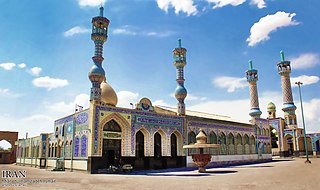
Tehran province is one of the 31 provinces of Iran. Its capital is the city of Tehran.

Karaj is a city in the Central District of Karaj County, Alborz province, Iran, serving as capital of the province, the county, and the district. The earliest records of Karaj date back to the 30th century BC. The city was developed under the rule of the Safavid and Qajar Empire and is home to historical buildings and memorials from those eras. This city has a unique climate due to access to natural resources such as many trees, rivers, and green plains. After Tehran, Karaj is the largest immigrant-friendly city in Iran, so it has been nicknamed "Little Iran."
Gulistan, Golestan or Golastan means "flower land" in Persian language.

Mianeh is a city in the Central District of Mianeh County, East Azerbaijan province, Iran, serving as capital of both the county and the district. It is the fourth most populous city of the province.
Khavaran cemetery is an irregular unmarked cemetery located in southeast Tehran. The graves in the cemetery do not have any marking on them. The Islamic Republic of Iran does not allow the families of the dead to mourn in the cemetery and the identity of those who were buried in the cemetery is unknown to their relatives. Khavaran initially was a traditional burial ground for religious minorities, "on the grounds that they were apostates and must not contaminate the resting place of Muslims." During the 1988 executions of Iranian political prisoners committed by the Islamic Republic of Iran, the government used Khavaran as the site of unmarked mass graves for those killed. The portion of the cemetery in which the political prisoners are buried is colloquially known as lanatabad (لعنتآباد), place of the damned.

Mohsen Hashtroodi (Hachtroudi) (Persian: محسن هشترودی; also romanized as Mohsen Hashtrūdi; December 13, 1908, Tabriz – September 4, 1976, Tehran) was a prominent Iranian mathematician, known as "Professor Hashtroodi (Hashtroudi)". His father, Shaikh Esmāeel Mojtahed was an advisor to Shaikh Mohammad Khiābāni, who played a significant role in the establishment of the parliamentary democracy in Iran during and after the Iranian Constitutional Revolution.
Iran has rapid transit systems operating in five cities, and others are under construction.

Freeway 7 is a freeway in central Iran. It starts from Jahad Square at the south end of Kazemi Expressway and Azadegan Expressway in Tehran. It then passes Behesht-e Zahra, Imam Khomeini Int'l, Qom, Kashan, Natanz, Shahinshahr, Najafabad and currently ends at the northeast of Zarrinshahr in a junction with Road 51 and Zobahan Freeway. However, there has been construction after the junction and so far, 7 kilometres (4.3 mi) has been completed. In recent years, construction has been made in order to connect this freeway to Shiraz under the name Esfahan-Shiraz Freeway, which starts from Izadkhast and currently ends at the northwest of Shiraz in a junction with Road 67, and it is planned to end in Hosseini Al-Hashemi Expressway. It was opened in Mehr 1402. The Freeway from Isfahan to Izadkhast is currently planned, but yet to start construction. There are also plans to connect the freeway to Bushehr.

Doulab Cemetery is a historical cemetery situated in the eastern suburbs of Tehran, Iran. One of the most important Christian cemeteries, it consists of five sections:

The 2013–14 Hazfi Cup was the 27th season of the Iranian football knockout competition. Sepahan was the defending champion, but was eliminated by Sanat Naft in the Round of 32. The competition started on 4 September 2013 and ended on 14 February 2014. Tractor won the title, defeating Mes Kerman in the final.
The article contains information about the 2013–14 Iran 3rd Division football season. This is the 4th rated football league in Iran after the Persian Gulf Cup, Azadegan League, and 2nd Division. The league started from September 2013.

The following is a timeline of the history of the city of Isfahan, Iran.

Sheikhan cemetery is the second historical cemetery in the Islamic world and one of the oldest cemeteries in Qom, Qom Province, Iran which is located near the Fatima Masumeh Shrine. The cemetery dates back over a thousand years.

Golestan Shahada of Isfahan is a cemetery in Isfahan, Iran which is located near Takht-e Foulad Mausoleum. People buried there include Mohammad Ali Naseri, Abdoldjavad Falaturi, Mohammad Reza Zahedi, Husayn Kharrazi, Ahmad Kazemi, Mahmoud Shahbazi, Akbar Agha Babaei, Mohammad Hejazi, Gholamreza Yazdani, Abdullah Maithami and Ata'ollah Ashrafi Esfahani. This cemetery was formed on April 28, 1976, with the burial of Abulhasan Shamsabadi. This mausoleum is the second great cemetery of Iran's martyrs.

Golzar Shahada of Qom or Golzar Shahada Ali Ibn Jafar is a cemetery in Qom, Iran. This cemetery is the burial place of famous and historical people, also burial place of the martyrs of the Iran-Iraq war. This cemetery is the largest cemetery in Qom province. This cemetery is known as the second national cemetery of Iran with 3,000 martyrs belonging to the Iran-Iraq war and more than a thousand international martyrs. In this cemetery, prominent and important people are buried, including the martyrs related to the events of the Iranian revolution and the victims related to the Mena incident. Also, apart from Qomi and Iranian martyrs, there are also Iraqi martyrs who refused to fight in the Iraqi front, so they fought alongside the Iranian fighters against the Ba'ath regime and are buried in this cemetery.










